At Laurentian University in Northern Canada, a team of well-educated individuals, headed by Professor Dean Millar, Full Professor at the Bharti School of Engineering, are striving to make the old new again. Their efforts are directed toward developing commercially viable hydraulic air compressors (HACs) for the world to use, especially since these devices can more efficiently produce compressed air isothermally, rather than through polytropic compression as with a typical mechanical air compressor.
In pursuing this goal the team is building on engineering concepts that were used to develop the first hydraulic air compressor at Dominion Cotton Mills, Magog, Quebec, Canada, over 100 years ago. The basic principles of the HAC were then used to produce compressed air at 17 locations worldwide, including the last at Ragged Chutes near Cobalt, Ontario, Canada, over 100 years ago. This article discusses the development the HAC in this decade and the continuing work at Laurentian University, Ontario, to modernize the concept.
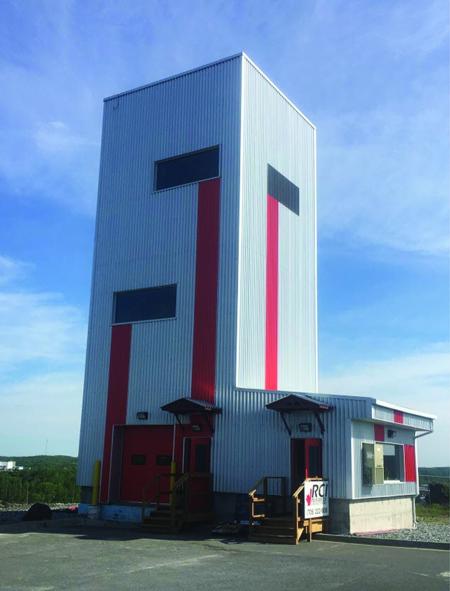
This demonstration HAC was built at Dynamic Earth in Sudbury, Canada, and is open for tours to allow visitors to see the technology. Photo courtesy of Electrale Innovation Limited.
Taylor’s Hydraulic Air Compressor
Professor Millar said his interest in the HAC technology started with a bit of serendipity.
“I was at the local Vale smelter in Sudbury studying the design of a direct-contact heat exchanger, and then someone told me to go have a look at an industrial heritage website where I came across a diagram of Taylor’s Hydraulic Air Compressor at Ragged Chutes,” Millar said. “At first I thought I was looking at a 100-year-old direct contact heat exchanger, but then realized this device was both an air compressor and a heat exchanger, and the design could be used to improve compression efficiency compared to current methods.”
Millar, a mining engineer who also cut his teeth in his formative years working on wave power generation in the United Kingdom, was fascinated. It was the start of a wonderfully interesting project, improving on Charles Havelock Taylor’s design to make it more useful for industry. Taylor was a New Brunswick businessman and engineer.
As the story goes, it was during the construction phase of a water dam in Quebec in 1895 when Taylor noticed something strange during winter conditions. Specifically, the water flow through the dam spillway carried air bubbles under the river ice, which then pushed up to form ice domes. When probing the dome, Taylor noticed the air beneath the ice was compressed due to the weight of the water.
Taylor immediately realized there were commercial uses for this phenomenon and started to experiment with hydraulic air compressor models in his Montreal warehouse; he soon had enough confidence to persuade investors to form Taylor Air Compressor Company, building the first commercial hydraulic air compressor for Dominion Textile, a 155-horsepower (hp) assembly putting out 52 psi at 60% efficiency. The unit operated successfully until 1953 when fabric weaving machine technology changed and pressures had to increase.
Two other air compressors were built in the late 1800’s, including one with a 1,354-foot wooden plume, and one at Peterborough Lift Lock in Canada, which caught the interest of companies worldwide. In the early 1900’s, two other plants were built in Washington state and Michigan, with pressures reaching 117 psi. Other plants were constructed in Germany and Peru.
Enough Air to Power Multiple Mines
Taylor’s crowning achievement was the development of the Ragged Chutes HAC on the Montreal River in Cobalt. Mineral deposits of silver, cobalt and nickel were found in around 1884 in this then isolated area located about 300 miles directly north of Toronto, Canada, and about 100 miles North East of Sudbury, Ontario.
Transmitted electrical power was not available, and coal power was thought to be too expensive, so it fell on the mine developers to come up with an economical way to power mine power tools and drills, which were pneumatically operated, as some are today. Taylor paid a visit to the area and found conditions suitable for a hydraulic air compressor, so plans were put in place to harness the nearby Montreal River to provide water power.
This HAC was built and placed in service in 1910 and was by no means a small device. The capacity of the air compressor was 40,000 cfm at a pressure of 120 psi compressed through dual downcomers, measuring 8.5 feet in diameter and 341 feet in depth carved into the Canadian Shield rock. An underground cavern, used to separate the air from water, was 927 feet long and 20 by 26 feet in width. The air compressor was connected to approximately 30 mines in the area using 40 kilometers of 24-inch steel pipe. There was enough compressed air volume in the system to power the various mines for a week with the air compressor shut down.
Leveraging River Water at Ragged Chutes
The HAC at Ragged Chutes used the flow of river water across an elevation change in the Ragged Chutes rapids to provide flow into the network of caverns. The river did not provide the full 341 feet of head required to compress to 120 psi, it only needed to push the water first through the inlet shafts, then through the separation chamber, and then up though the discharge shaft that returns the water to the river.
As the water flows into the intake shaft, it carries with it entrained air bubbles. As the air gets deeper and deeper into the water column the compression takes place. Unlike a normal air compressor, the compressed air temperature does not rise appreciably, making the compression process isothermal as detailed in Figure 1, which is the most efficient way to compress the gas. Pressure regulation is provided by a blow-off system. As the air pressure increases the water level in the underground chamber lowers, uncovering the end of a blow off pipe. This is the most impressive part of the old Ragged Chutes air compressor. The blow-off of compressed air and water created a plume reaching 220 feet in the air.
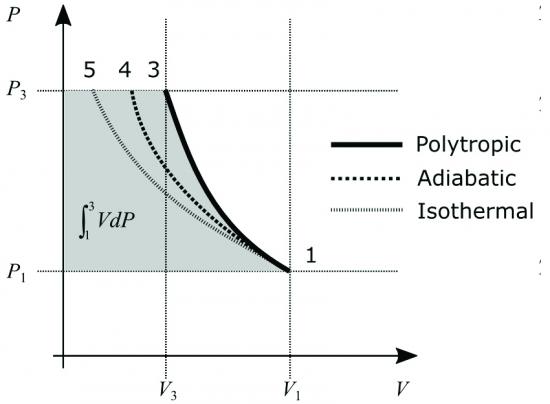
Figure 1: The hydraulic compressor is nearly isothermal (light-dotted grey line). Therefore, the production of compressed air requires less work than a standard polytropic compressor (black solid line). Chart courtesy of Electrale Innovation Limited.
This air compressor had no moving parts and required no external energy input. Once its construction cost was paid for it essentially gave free compressed air over its 70-year lifespan. The air compressor in its applied design, however, required a good supply of river water and a very deep hole in the ground, conditions that are not always available where compressed air is needed. However some of these requirements are present in modern day mine sites. With a few modifications to the design, it was felt by the Laurentian University team that a viable HAC could be constructed without river water power. (For more about the Ragged Chutes HAC, visit http://www.cobaltmininglegacy.ca/power.php.)
Making the Old New
Research on reviving the use of hydraulic air compressors started when the mining industry was looking for ways to efficiently power turbo coolers for reduction of ambient air temperature in ultra-deep mines. If this could be done economically the depth of the mines could be extended, prolonging the life of some mines by a decade or two.
After a few years of research a group of organizations wrote a paper, “Conceptual Design of a Modern-day Hydraulic Air Compressor,” and presented it at the 2015 International Conference on Efficiency, Cost, Optimization, Simulation and Environmental Impact of Energy Systems. The paper proposed construction of an HAC demonstrator unit in Sudbury at Science North’s Dynamic Earth. The construction of the unit was completed in the summer of 2017. It was used for testing to prove predicted efficiency and the viability of commercial-sized air compressors.
The demonstration unit differs from the Ragged Chutes air compressor in that the head of water used to provide the down flow of water in the intake shaft, and the entrainment of bubbles, is now provided by a system of parallel pumps. In addition, the water flow operates in a closed loop rather than being a once-through design.
HAC units of modern design are projected to provide much longer useful life than standard screw-type air compressors and be easier to maintained once installed due to the few moving parts. The units are capable of variable flow due to the design, making it easy to match the output to the demand. The production provides cool and clean oil-free air that does not contain excess moisture that might be produced by air-cooled air compressors in hot environments.
For demonstration and testing purposes there are actually three models of HAC units at the University, including a tabletop “PortaHAC” unit used to demonstrate the basic principles shown in Figure 1, a laboratory sized model, and the unit at Dynamic Earth producing about 30 psi.
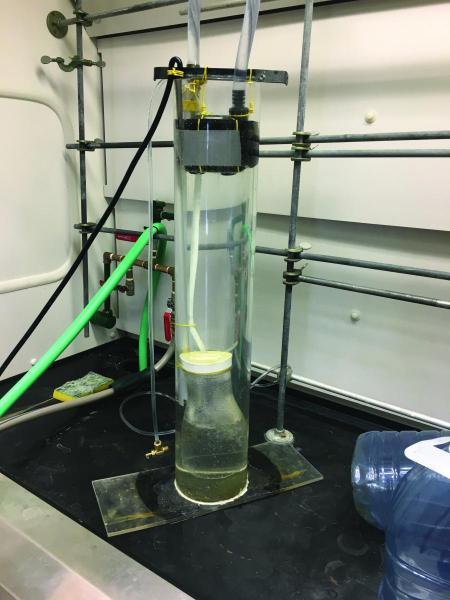
This PortaHAC tabletop unit demonstrates the basic principles of a HAC on a small scale. A video of a working model can be viewed at https://www.youtube.com/watch?v=Sqn0nThkPh4&feature=youtu.be.
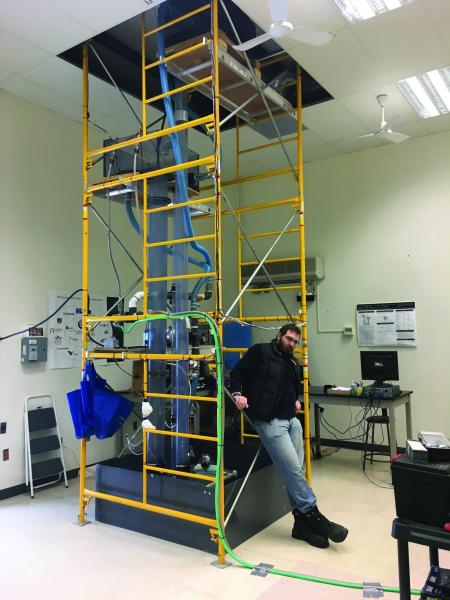
This laboratory-scale HAC, which is about 15 feet tall, is used for basic testing in a controlled environment. Alex Hutchison (pictured) is a Project Engineer with Electrale Innovation Limited. He played a key role in the development of the modern HAC.
The extensive testing of these units with very precise instrumentation has confirmed that the modern closed-loop design produces compressed air within expectations at around 71% efficiency. In terms of specific power the demonstration unit achieves 10.9 kW per 100 cfm at 31 psi discharge pressure while producing 244 scfm of compressed air. The most important theoretical prediction confirmed experimentally at the HAC demonstrator is that the temperature rise of the air during compression is consistently and repeatedly on the order of 0.01 °C – nearly isothermal!
Work is proceeding on the design of the HAC unit for a number of interested clients worldwide. Electrale Innovation Limited, a company formed by Professor Millar, who also serves as the company CEO, is in the business of promoting commercial development of the modern HAC. The company’s estimates show specific power of 14 kW/100 cfm is expected for an example system producing 5,000 acfm of oil-free air at 140 psi as shown in Figure 2.
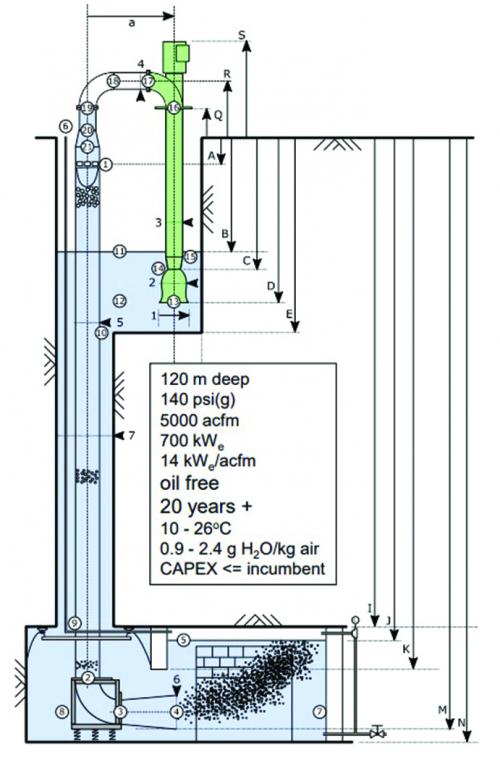
Figure 2: Shown is a conceptual diagram of a large scale HAC for the mining industry that would produce 5,000 acfm at 140 psi at a specific power of 14 kW/100 cfm. The unit is expected to have a 20-plus year lifespan. Image courtesy of Electrale Innovation Limited.
“We are looking to develop commercial large-scale Hydraulic Air Compressors for both underground and above ground installations.” said Professor Millar. “Think of a large wind turbine with no rotor or nacelle at the top. This could be the configuration of modern HAC units where there are no mine shafts to use.”
He said efforts are continuing to develop very large scale HAC units, where it seems the bigger they are, the more efficient and economical they become.
Energy Efficiency for Large Applications
The work in developing the modern day HAC shows some old ideas can become new again and will be useful in providing energy efficient solutions for large industrial applications. HAC units can be used to produce a large flow of good quality compressed air through a simple process that requires minimal maintenance and lasts for decades. And with above-ground HAC units the sky is the limit!
For more information about the HAC project, please contact Dean Millar, CEO, Electrale Innovations Limited, email: dmillar@electrale.com; tel: 705-918-1613, or visit https://electrale.com/.
For more information about this article, contact Ron Marshall, Marshall Compressed Air Consulting, tel: 204-806-2085, email: ronm@mts.net.
To read similar Air Compressor Technology articles visit www.airbestpractices.com/technology/air-compressors.




